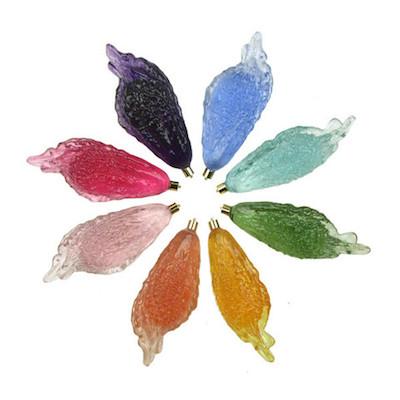This holiday season at the LACMA Store, Grant Breding, associate vice president of retail and merchandising, had the idea to commission Los Angeles–based designers the Haas Brothers to create a holiday ornament exclusive to LACMA. The first installment of what Breding hopes will be a yearly tradition, the Haas Brothers’ ornament is inspired by several works in LACMA’s permanent collection that were included in the exhibition Drawing Surrealism, which ran from October 21, 2012, to January 5, 2013. The holiday ornament initiative follows in the vein of Wear LACMA, a project that invites L.A. designers to produce items for sale at the LACMA Store inspired by works in the collection.
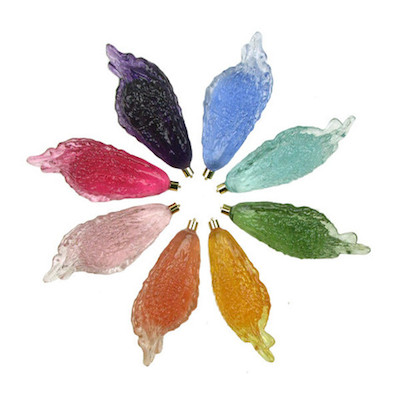 These ornaments, which come in multiple colors, are inspired by the exhibition Drawing Surrealism.
These ornaments, which come in multiple colors, are inspired by the exhibition Drawing Surrealism.
Otherwise known as twins Nikolai and Simon Haas, the Haas Brothers meld their backgrounds in music (Nikolai) and painting (Simon), as well as experience in design and construction, to create a multifaceted range of original art pieces, furniture, objects, and one-of-a kind commissions. Clients for their innovative and often playful projects have included Lady Gaga, Lita Albuquerque, Versace Home, and TV on the Radio.
Breding recently spoke with Simon and Nikolai Haas about their inspiration for the ornament design, their process, and their connection to LACMA.
Grant Breding: I understand you were both born in Los Angeles and spent some time here as children. Do you have memories of coming to LACMA? If so, what did you connect with?
Simon and Nikolai Haas: We were born in L.A. and lived here until we were four, when we moved to Austin, Texas, but our older brother stayed in L.A. and our mom was working here as a screenwriter, so Los Angeles was a second home until we moved back as adults. Our earliest memories of LACMA are from childhood trips to the tar pits [the LaBrea Tar Pits at the adjacent Page Museum]. . . . We used to walk [LACMA’s] grounds and remember the sculpture garden, especially the Calder mobile [Three Quintains (Hello Girls)].
Breding: I think the best part about an encyclopedic museum such as LACMA is that is serves as a resource or database for artists and designers to access art and design from all periods of time. Is there a time period in the museum that you gravitate toward?
 George Bellows, Cliff Dwellers, 1913, Los Angeles County Fund
George Bellows, Cliff Dwellers, 1913, Los Angeles County Fund
Haas Brothers: We really enjoy the collection of early-1900s American art in the permanent collection. We feel like the paintings of American life, like George Bellows's Cliff Dwellers, have a feeling of newness and excitement that we vibe with—a feeling that comes from breaking away from European traditionalism. There is an almost cartoonishly American feeling to these works that we find both humorous and inspired, and we like to think that our own work is colored by our American experience in a similar way.
Breding: The holiday ornament you made for us is incredibly beautiful. The directions I gave you were very simple: to find something you are inspired by at the museum and create an ornament based on that. Tell us about your specific inspiration for the ornament.
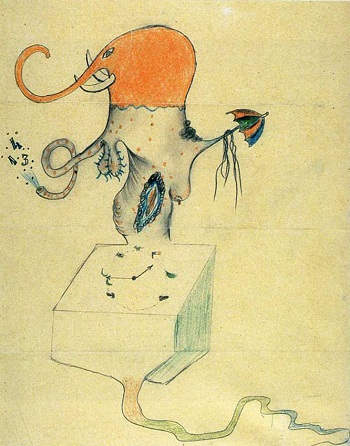 Andre Breton, Yves Tanguy, Marcel Duhamel, Max Morise, Cadavre exquis, 1926, collection of Gale and Ira Drukier, photo © 2012 Museum Associates/LACMA
Andre Breton, Yves Tanguy, Marcel Duhamel, Max Morise, Cadavre exquis, 1926, collection of Gale and Ira Drukier, photo © 2012 Museum Associates/LACMA
Haas Brothers: The ornament was inspired by LACMA's surrealist drawing exhibit [Drawing Surrealism, October 21, 2012–January 5, 2013], especially the drawing technique decalcomania [a process of applying material, such as paint, to paper, and folding and unfolding the paper, or pressing it to other surfaces, to create mirrored or blotted images]. While not a direct translation of decalcomania from 2-D to 3-D, the process for our ornament was inspired by the simple concept of using the innate physical characteristics of two materials to generate an image or form organically. In decalcomania, gouache makes visible the physics of peeling two surfaces apart—our ornament shows what happens when a soft surface's substrate contracts. The playfully sexual exquisite corpse drawing by [Andre] Breton, [Yves] Tanguy, [Marcel] Duhamel and [Max] Morise [Cadavre exquis, 1926] also resonated with us, so we have chosen to embrace the naturally testicular shape that resulted from this process.
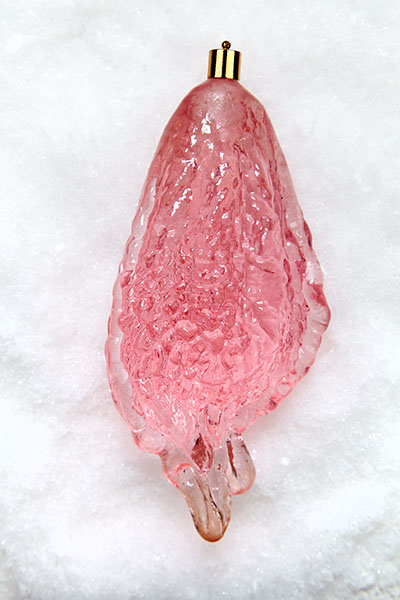 The Haas Brothers were interested in the drawing technique decalcomania (the process of transferring designs from paper to surfaces). The process inspired their creation of this ornament.
The Haas Brothers were interested in the drawing technique decalcomania (the process of transferring designs from paper to surfaces). The process inspired their creation of this ornament.
Breding: The process and technique you used to make them is fascinating. Can you explain how it was done?
Haas Brothers: For our ornament, a balloon covered in curing resin is strategically expanded and contracted so that the shrinking latex forces the soft resin to form a beautiful natural pattern similar to the way that fingers and toes wrinkle in water. There are many variations in the types of surfaces that can be achieved through this process, but we were most drawn to the wrinkling and curling that almost-cured resin formed, so our actions had to be very carefully timed. The final production pieces are individually hand-dyed and cast in solid resin so that each piece is slightly different from the next.
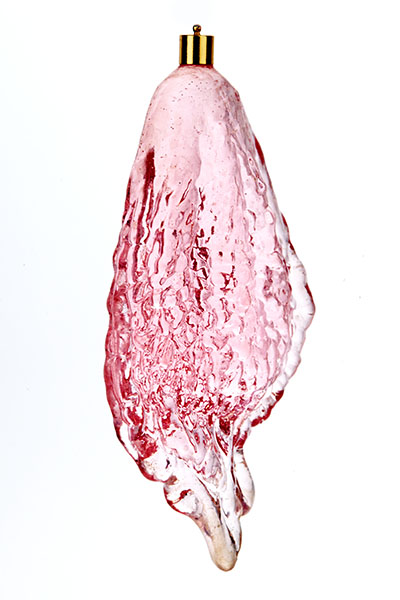
The Haas Brothers’ ornaments are available at the LACMA Store and the LACMA Store website now.



